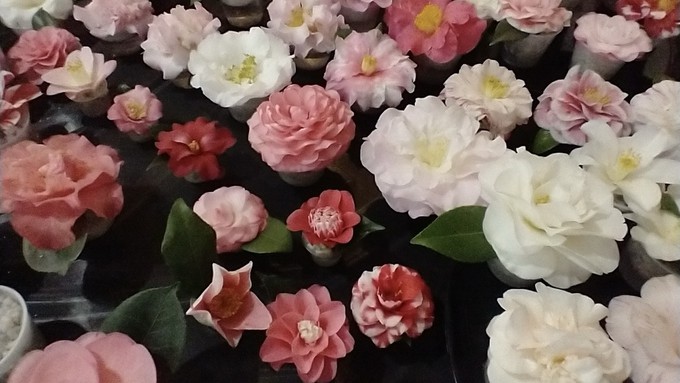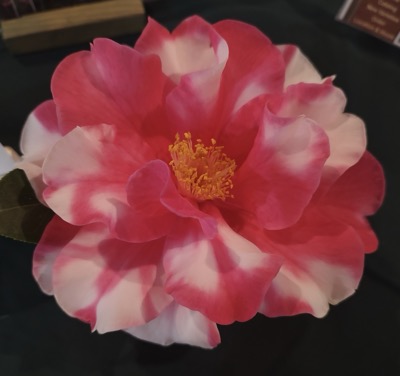
Milestone event to be at new location: Scottish Rite Center

These camellia blossoms were displayed on the trophy table during the 2022 Camellia Show. Debbie Arrington
For a special milestone, Camellia City is celebrating its namesake flower in style – with an amazing camellia show and sale at a new location.
This weekend, March 2 and 3, the Camellia Society of Sacramento will host the 100th annual Camellia Show at the Scottish Rite Center, 6151 H St., Sacramento. Show hours are 3 to 6 p.m. Saturday, 10 a.m. to 5 p.m. Sunday. Admission is free.
In addition to the show, the society will offer more than 250 camellia plants for sale, mostly in unusual and hard-to-find varieties. Proceeds from the sale help support the show. Donations are also welcome.
As a special commemorative, the society will sell buttons and refrigerator magnets saluting the 100th anniversary. A popular attraction is camellia waxing – preserved blooms encased in wax.

Highlighting the show, hundreds of blooms will be on display, with a trophy table packed with the very best. In addition, a photo contest will present camellias at their peak of beauty. Flower arrangements featuring camellias will be displayed by the Sacramento Floral Design Guild and Ikebana International, Sacramento.
The public is invited to enter blooms from their own gardens. Entry deadline is 10 a.m. Saturday; doors open at 7:30 a.m for entries.
First held in 1924, the Sacramento Camellia Show predates the local Camellia Society (which formed in 1943) by almost two decades. The early show took a year off in 1933 due to a hard freeze in December 1932 that destroyed camellia buds.
Before the Camellia Society took over, the first shows were run by the Tuesday Club (a local women’s literary and social club that at one time had 1,200 members) and then the Sacramento Garden Club, which formed in part to organize the camellia show.
Camellias were so popular because, at that time, almost everyone seemed to have at least one bush in their garden. Many heritage camellia plants, dating back several decades, still dot local parks and public places.
Sacramento’s camellia history dates back to the Gold Rush era: In 1852 a local nurseryman imported thousands of camellia plants from Japan. James Warren thought he was getting Camellia sinensis – the common tea plant; these plants could be in demand for tea-loving Chinese workers and miners. Instead, Warren received flowering camellias (most likely Camellia japonica). He sold them to Sacramento customers to decorate their gardens.
Thriving in Sacramento’s climate, these imported camellias quickly became popular; they bloom in late winter when few other plants do. Their shiny foliage looks good year-round.
By the 1920s, Sacramento leaders marketed their town as the Camellia City with its own Camellia Festival. Modeled after Pasadena’s Tournament of Roses, the festival featured a royal court, parade, formal dance and even a football game.
Focusing on the flower, the Camellia Society still showcases Sacramento’s favorite bloom – long after the Camellia Bowl played its final down. Thanks to their efforts, camellias are still being enjoyed – and celebrated – in Sacramento today.
For more details: https://camelliasocietyofsacramento.org/events.
Comments
0 comments have been posted.Sacramento Digs Gardening to your inbox.
Food in My Back Yard Series
May 6: Maintain soil moisture with mulch for garden success
April 29: What's (already) wrong with my tomato plants?
April 22: Should you stock up on fertilizer? (Yes!)
April 15: Grow culinary herbs in containers
April 8: When to plant summer vegetables
April 1: Don't be fooled by these garden myths
March 25: Fertilizer tips: How to 'feed' your vegetables for healthy growth
March 18: Time to give vegetable seedlings some more space
March 11: Ways to win the fight against weeds
March 4: Potatoes from the garden
Feb. 25: Plant a fruit tree now -- for later
Feb. 18: How to squeeze more food into less space
Feb. 11: When to plant? Consider staggering your transplants
Feb. 4: Starting in seed starting
Sites We Like
Garden Checklist for week of May 4
Enjoy this spring weather – and get gardening!
* Plant, plant, plant! It’s prime planting season in the Sacramento area. Time to set out those tomato transplants along with peppers and eggplants. Pinch off any flowers on new transplants to make them concentrate on establishing roots instead of setting premature fruit.
* Direct-seed melons, cucumbers, summer squash, corn, radishes, pumpkins and annual herbs such as basil.
* Harvest cabbage, lettuce, peas and green onions.
* In the flower garden, direct-seed sunflowers, cosmos, salvia, zinnias, marigolds, celosia and asters. (You also can transplant seedlings for many of the same flowers.)
* Plant dahlia tubers. Other perennials to set out include verbena, coreopsis, coneflower and astilbe.
* Transplant petunias, marigolds and perennial flowers such as astilbe, columbine, coneflowers, coreopsis, dahlias, rudbeckia and verbena.
* Keep an eye out for slugs, snails, earwigs and aphids that want to dine on tender new growth.
* Feed summer bloomers with a balanced fertilizer.
* For continued bloom, cut off spent flowers on roses as well as other flowering plants.
* Add mulch to the garden to maintain moisture. Mulch also cuts down on weeds. But don’t let it mound around the stems or trunks of trees or shrubs. Leave about a 6-inch to 1-foot circle to avoid crown rot or other problems.